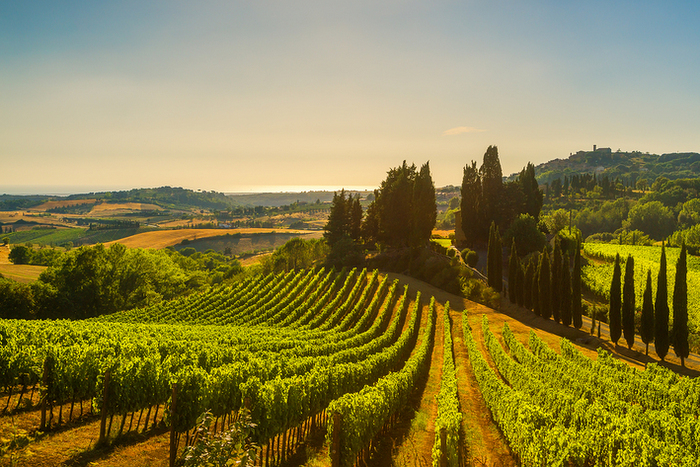Tuscany, one of Italy’s most celebrated wine regions, is renowned for its beautiful rolling hills, sun-drenched vineyards and ancient winemaking traditions. The region’s wines are primarily produced from the native Sangiovese red grape, which gives rise to iconic reds such as Chianti Classico, Brunello di Montalcino and Vino Nobile di Montepulciano. White wines make up only about a fifth of the region’s total production. Tuscany also produces the acclaimed Super Tuscan wines, which originated in an area close to sea known as the Maremma. These are modern blends that often incorporate international grape varieties such as Cabernet Sauvignon and Merlot, combining both innovation and traditional respect for the terroir. With its diverse microclimates and dedication to quality, Tuscany stands as a symbol of Italian wine excellence and cultural heritage. Many of our tours travel through this wonderful region including Lucca, Volterra and Elba, A Tuscan Harvest and Etruscan Trails in Central Italy.

Key White Grapes from Tuscany
Vernaccia – The region’s most famous native white grape, best known for Vernaccia di San Gimignano. It produces crisp, mineral-driven wines with notes of citrus, almond and herbs.
Trebbiano Toscano – One of Italy’s most widely planted white varieties, often used in blends. It yields light, fresh wines with subtle fruit and floral notes and is also used in the production of Vin Santo, Tuscany’s traditional dessert wine.
Malvasia del Chianti – A member of the huge Malvasia family, this grape is commonly blended with Trebbiano for both dry and sweet wines, especially Vin Santo.
Vermentino – Grown mainly along the Tuscan Mediterranean coast, this aromatic grape produces lively, fresh wines which complement the local seafood.
Chardonnay and Sauvignon Blanc are two international varieties that have found success in Tuscany, particularly in Super Tuscan white blends.

Key Red Grapes from Tuscany
Sangiovese – The dominant and most important red grape of Tuscany, forming the backbone of many of its most famous wines. It has ancient origins and expresses itself in many different ways from lightly fruity if vinified in steel, to spicy and robust with great ageing potential, if matured in oak.
Canaiolo Nero – Another historic variety used in the traditional Chianti blend to soften tannins and add fruitiness and colour.
Ciliegiolo – The grape’s name comes from the Italian word for cherry, a fruit which Ciliegiolo wines resemble both in colour and aroma. It is thought to have come to Tuscany via pilgrims returning from Santiago de Compostela in Spain.
Colorino – Slightly more obscure than the grapes above, this is often used in small amounts for its deep colour and structure as a blending grape; it also enhances the longevity of blends.
International varieties including Cabernet Sauvignon, Merlot and Syrah thrive in Tuscany and are used in the Super Tuscan wines described below.

Top Wine Denominations in Tuscany
Chianti – The largest and most historic denomination, encompassing much of central Tuscany. Wines are primarily made from Sangiovese, offering bright acidity and red fruit flavours. This area is divided into 7 subzones: Chianti Colli Senesi, Chianti Colli Fiorentini, Chianti Colli Aretini, Chianti Colli Pisane, Chianti Montalbano, Chianti Montespertoli and Chianti Rufina.
Chianti Classico – The historic heartland of Chianti between Florence and Siena, with bottles from this zone bearing the symbol of the Gallo Nero (Black Rooster). These wines tend to be more structured and complex than basic Chianti.
Brunello di Montalcino – One of Italy’s finest reds, made exclusively from Sangiovese (locally called Sangiovese Grosso or Brunello) and aged extensively for power, depth and longevity.
Vino Nobile di Montepulciano – Another classic Sangiovese-based wine (the grape is known locally as Prugnolo Gentile), elegant and balanced, with a long history of noble production.
Morellino di Scansano – Produced in the coastal Maremma region, these wines are softer and fruitier expressions of Sangiovese, known locally as Morellino.
Carmignano – A small but historic area west of Florence where Sangiovese is blended with Cabernet Sauvignon and Cabernet Franc, a practice dating back centuries.
Vernaccia di San Gimignano – Tuscany’s flagship white wine denomination, known for crisp, mineral-driven wines.

Wine Tip
We often hear the term “Super Tuscan” in relation to this region. It covers wines made with blends of Cabernet Sauvignon, Merlot and other international varieties. These wines emerged in the late 20th century, breaking away from traditional Italian wine regulations. Many were created by winemakers around Bolgheri close to the Tuscan coast. Their aim was to produce more expressive, world-class wines than the rigid local laws allowed. Because they didn’t conform to official regulations, they were originally classified as simple “Vino da Tavola” (table wine) despite their high quality. Over time, the excellence of these experimental wines—like Sassicaia, Tignanello, and Ornellaia—earned international acclaim and commanded phenomenal prices. Combining traditional and modern winemaking techniques, these innovative winemakers continue to produce powerful, elegant and age-worthy wines.

